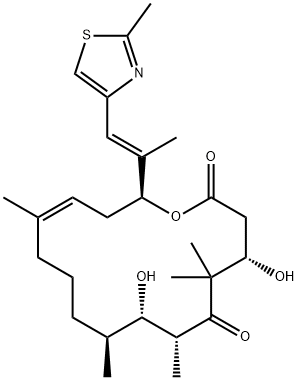Epothilones are microtubule-stabilizing agents with potential anti-neoplastic actions. They are natural macrolides that have high potency in both taxane-sensitive and taxane-resistant models. Epothilone D is a desoxy form of epothilone B ones are microtubule-stabilizing agents with potential anti-neoplastic actions. They are natural macrolides that have high potency in both taxane-sensitive and taxane-resistant models. Epothilone D is a desoxy form of epothilone B ones are microtubule-stabilizing agents with potential anti-neoplastic actions. They are natural macrolides that have high potency in both taxane-sensitive and taxane-resistant models. Epothilone D is a desoxy form of epothilone B ones are microtubule-stabilizing agents with potential anti-neoplastic actions. They are natural macrolides that have high potency in both taxane-sensitive and taxane-resistant models. Epothilone D is a desoxy form of epothilone B ones are microtubule-stabilizing agents with potential anti-neoplastic actions. They are natural macrolides that have high potency in both taxane-sensitive and taxane-resistant models. Epothilone D is a desoxy form of epothilone B ones are microtubule-stabilizing agents with potential anti-neoplastic actions. They are natural macrolides that have high potency in both taxane-sensitive and taxane-resistant models. Epothilone D is a desoxy form of epothilone B ones are microtubule-stabilizing agents with potential anti-neoplastic actions. They are natural macrolides that have high potency in both taxane-sensitive and taxane-resistant models. Epothilone D is a desoxy form of epothilone B ones are microtubule-stabilizing agents with potential anti-neoplastic actions. They are natural macrolides that have high potency in both taxane-sensitive and taxane-resistant models. Epothilone D is a desoxy form of epothilone B ones are microtubule-stabilizing agents with potential anti-neoplastic actions. They are natural macrolides that have high potency in both taxane-sensitive and taxane-resistant models. Epothilone D is a desoxy form of epothilone B ones are microtubule-stabilizing agents with potential anti-neoplastic actions. They are natural macrolides that have high potency in both taxane-sensitive and taxane-resistant models. Epothilone D is a desoxy form of epothilone B ones are microtubule-stabilizing agents with potential anti-neoplastic actions. They are natural macrolides that have high potency in both taxane-sensitive and taxane-resistant models. Epothilone D is a desoxy form of epothilone B ones are microtubule-stabilizing agents with potential anti-neoplastic actions. They are natural macrolides that have high potency in both taxane-sensitive and taxane-resistant models. Epothilone D is a desoxy form of epothilone B ones are microtubule-stabilizing agents with potential anti-neoplastic actions. They are natural macrolides that have high potency in both taxane-sensitive and taxane-resistant models. Epothilone D is a desoxy form of epothilone B ones are microtubule-stabilizing agents with potential anti-neoplastic actions. They are natural macrolides that have high potency in both taxane-sensitive and taxane-resistant models. Epothilone D is a desoxy form of epothilone B ones are microtubule-stabilizing agents with potential anti-neoplastic actions. They are natural macrolides that have high potency in both taxane-sensitive and taxane-resistant models. Epothilone D is a desoxy form of epothilone B ones are microtubule-stabilizing agents with potential anti-neoplastic actions. They are natural macrolides that have high potency in both taxane-sensitive and taxane-resistant models. Epothilone D is a desoxy form of epothilone B ones are microtubule-stabilizing agents with potential anti-neoplastic actions. They are natural macrolides that have high potency in both taxane-sensitive and taxane-resistant models. Epothilone D is a desoxy form of epothilone B ones are microtubule-stabilizing agents with potential anti-neopla

